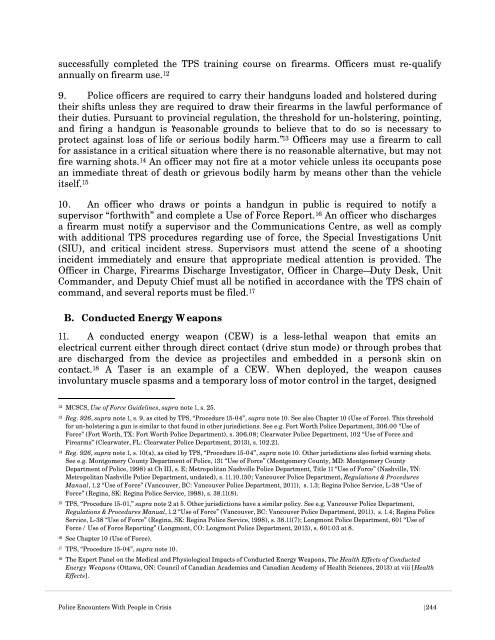Police-Encounters-With-People-In-Crisis
Police-Encounters-With-People-In-Crisis
Police-Encounters-With-People-In-Crisis
Create successful ePaper yourself
Turn your PDF publications into a flip-book with our unique Google optimized e-Paper software.
successfully completed the TPS training course on firearms. Officers must re-qualify<br />
annually on firearm use. 12<br />
9. <strong>Police</strong> officers are required to carry their handguns loaded and holstered during<br />
their shifts unless they are required to draw their firearms in the lawful performance of<br />
their duties. Pursuant to provincial regulation, the threshold for un-holstering, pointing,<br />
and firing a handgun is “reasonable grounds to believe that to do so is necessary to<br />
protect against loss of life or serious bodily harm.” 13 Officers may use a firearm to call<br />
for assistance in a critical situation where there is no reasonable alternative, but may not<br />
fire warning shots. 14 An officer may not fire at a motor vehicle unless its occupants pose<br />
an immediate threat of death or grievous bodily harm by means other than the vehicle<br />
itself. 15<br />
10. An officer who draws or points a handgun in public is required to notify a<br />
supervisor “forthwith” and complete a Use of Force Report. 16 An officer who discharges<br />
a firearm must notify a supervisor and the Communications Centre, as well as comply<br />
with additional TPS procedures regarding use of force, the Special <strong>In</strong>vestigations Unit<br />
(SIU), and critical incident stress. Supervisors must attend the scene of a shooting<br />
incident immediately and ensure that appropriate medical attention is provided. The<br />
Officer in Charge, Firearms Discharge <strong>In</strong>vestigator, Officer in Charge—Duty Desk, Unit<br />
Commander, and Deputy Chief must all be notified in accordance with the TPS chain of<br />
command, and several reports must be filed. 17<br />
B. Conducted Energy Weapons<br />
11. A conducted energy weapon (CEW) is a less-lethal weapon that emits an<br />
electrical current either through direct contact (drive stun mode) or through probes that<br />
are discharged from the device as projectiles and embedded in a person’s skin on<br />
contact. 18 A Taser is an example of a CEW. When deployed, the weapon causes<br />
involuntary muscle spasms and a temporary loss of motor control in the target, designed<br />
12<br />
MCSCS, Use of Force Guidelines, supra note 1, s. 25.<br />
13<br />
Reg. 926, supra note 1, s. 9, as cited by TPS, “Procedure 15-04”, supra note 10. See also Chapter 10 (Use of Force). This threshold<br />
for un-holstering a gun is similar to that found in other jurisdictions. See e.g. Fort Worth <strong>Police</strong> Department, 306.00 “Use of<br />
Force” (Fort Worth, TX: Fort Worth <strong>Police</strong> Department), s. 306.08; Clearwater <strong>Police</strong> Department, 102 “Use of Force and<br />
Firearms” (Clearwater, FL: Clearwater <strong>Police</strong> Department, 2013), s. 102.21.<br />
14<br />
Reg. 926, supra note 1, s. 10(a), as cited by TPS, “Procedure 15-04”, supra note 10. Other jurisdictions also forbid warning shots.<br />
See e.g. Montgomery County Department of <strong>Police</strong>, 131 “Use of Force” (Montgomery County, MD: Montgomery County<br />
Department of <strong>Police</strong>, 1998) at Ch III, s. E; Metropolitan Nashville <strong>Police</strong> Department, Title 11 “Use of Force” (Nashville, TN:<br />
Metropolitan Nashville <strong>Police</strong> Department, undated), s. 11.10.150; Vancouver <strong>Police</strong> Department, Regulations & Procedures<br />
Manual, 1.2 “Use of Force” (Vancouver, BC: Vancouver <strong>Police</strong> Department, 2011), s. 1.3; Regina <strong>Police</strong> Service, L-38 “Use of<br />
Force” (Regina, SK: Regina <strong>Police</strong> Service, 1998), s. 38.11(8).<br />
15<br />
TPS, “Procedure 15-01,” supra note 2 at 5. Other jurisdictions have a similar policy. See e.g. Vancouver <strong>Police</strong> Department,<br />
Regulations & Procedures Manual, 1.2 “Use of Force” (Vancouver, BC: Vancouver <strong>Police</strong> Department, 2011), s. 1.4; Regina <strong>Police</strong><br />
Service, L-38 “Use of Force” (Regina, SK: Regina <strong>Police</strong> Service, 1998), s. 38.11(7); Longmont <strong>Police</strong> Department, 601 “Use of<br />
Force / Use of Force Reporting” (Longmont, CO: Longmont <strong>Police</strong> Department, 2013), s. 601.03 at 8.<br />
16<br />
See Chapter 10 (Use of Force).<br />
17<br />
TPS, “Procedure 15-04”, supra note 10.<br />
18<br />
The Expert Panel on the Medical and Physiological Impacts of Conducted Energy Weapons, The Health Effects of Conducted<br />
Energy Weapons (Ottawa, ON: Council of Canadian Academies and Canadian Academy of Health Sciences, 2013) at viii [Health<br />
Effects].<br />
<strong>Police</strong> <strong>Encounters</strong> <strong>With</strong> <strong>People</strong> in <strong>Crisis</strong> |244


